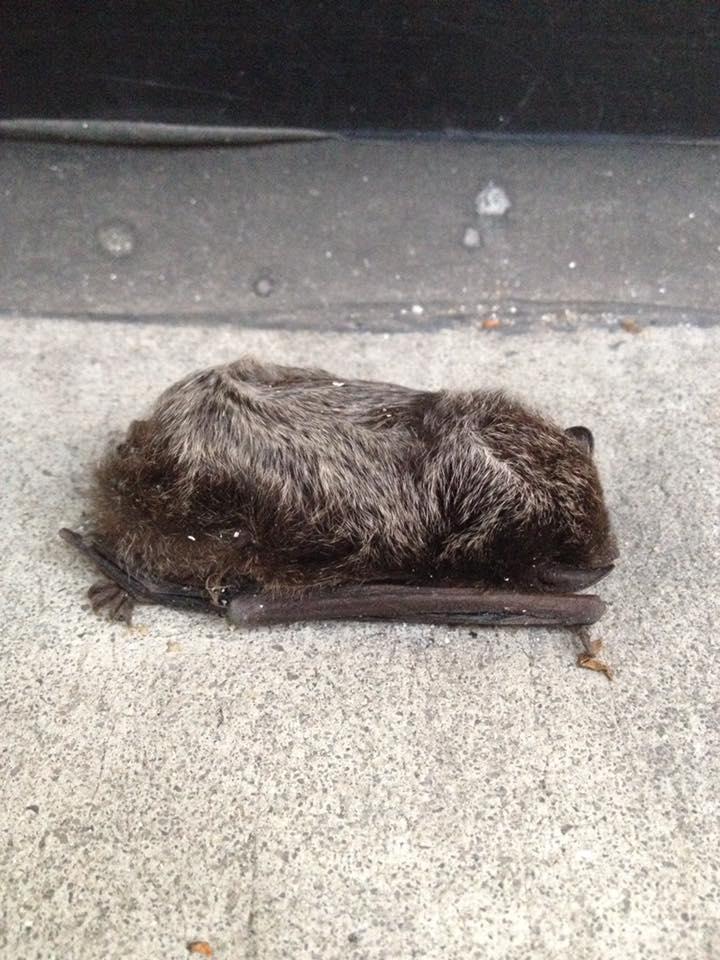Woodland Wildlife Spotlight: Which Bat is That?
From the Summer 2022 issue of Branching Out. Subscribe to Branching Out here. Read more Woodland Wildlife Spotlights here.

Eastern red bat roosting in Howard County, MD, 2019. Photo by Sue Muller, Maryland Biodiversity Project
From the Summer 2022 issue of Branching Out. Subscribe to Branching Out here. Read more Woodland Wildlife Spotlights here.
Bats have had centuries of bad publicity as, at best, oddball creatures, and at worst, connected to legends of vampires. Their reputations have been somewhat improved over the recent decades as science has discovered more of the species’ value to the environment, and as publicity of their plight related to White-nose Syndrome has widened. Consequently, more people are interested in helping bats in general, and in learning more about individual species in particular.
Maryland is home to ten different species of bats, all of which are listed by the state as Species of Greatest Conservation Need. They are generally divided into two groups: ”cave bats” and “tree bats.” The six species of cave bats found in Maryland are generally year-round residents and will spend the colder months hibernating in colonies in natural caves or in man-made tunnels. Tree bats, on the other hand, are more solitary and may migrate or spend the winter in tree cavities, under bark, or even under tree litter. Those found in Maryland include the Eastern red bat, the hoary bat, the silver-haired bat, and the evening bat. As we mostly discuss woodland species in this spotlight, let’s take a closer look at these four tree bats.
Eastern Red Bat
The most common bat in Maryland, the Eastern red bat generally roosts in south-facing deciduous trees 4-10 feet above the ground during the day, but may crawl beneath leaf litter on the coldest days. They often fly at dusk, hunting for moths, mosquitos, crickets, cicadas, and other insects. Some will migrate south for the winter, while others will seek out leaf litter or hollow trees for the colder months. Observers sometimes see them flying on warm winter days.


Hoary Bat
The hoary bat gets its name from the hoar frost appearance of the tips of its fur. The fur around its throat and forehead is yellow. Like the Eastern red bat, it has a fully furred tail. However, it is larger than the Eastern red bat; in fact, it’s the largest Maryland bat, with a wingspan of up to 16 inches. They tend to roost higher up in coniferous trees (up to 20 feet above the ground), often near cleared areas.
Silver-haired Bat
Unlike other tree bats, the silver-haired bat occasionally hunts in groups, flying low over both still and running water, and in forest openings. They are rarely found in Maryland during the summer, but some will linger into the fall and winter. They will shelter in a variety of locations, such as under loose bark or in woodpecker holes, or in manmade structures such as open sheds or outbuildings.


The evening bat may be confused with the larger big brown bat (one of the cave bats), because of similar coloration and because they may roost in colonies in buildings or in smaller numbers within hollow trees or under loose bark. Little is known about the evening bat’s winter habits; it may migrate south, but some may hibernate in Maryland.
Learn more about Maryland’s bats from the Maryland Department of Natural Resources’ Guide to Maryland’s Bats.
Branching Out, Vol. 30, no. 3 (Summer 2022)
Branching Out is the free, quarterly newsletter of the Woodland Stewardship Education program. For more than 25 years, Branching Out has kept Maryland woodland owners and managers informed about ways to develop and enhance their natural areas, how to identify and control invasive plants and insects, and about news and regional online and in-person events.